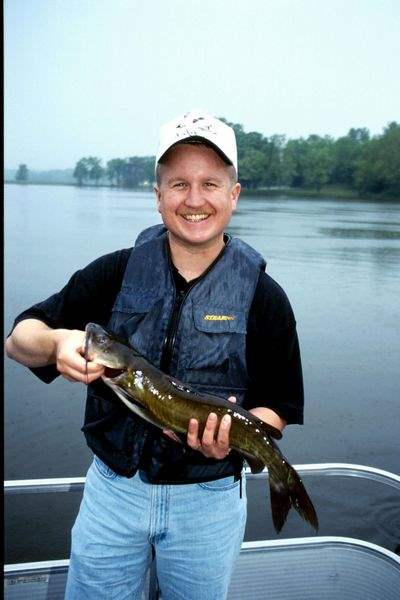
Following the fish: Bullhead fishing a springtime delight
5/7/2004
A channel catfish, with forked tail, is the bullhead's larger cousin.
TIM DANIEL/ODNR
Bullheading is pure fishing.
It is angling the way most folks traditionally envision it — relaxing, casual, communing with the outdoors. Free of competition, money and trophy-fish tension.
It soon will be at its best right as spring unfolds and the water still is cool and bullhead flesh is firm — perfect for the skillet.
These feisty, square-tailed brown catfish do not attain much size. Usually they run 10 to 12 inches and under a pound. But a bigger one usually gets some attention, especially if young fishermen are included in the angling party. Indeed, bullheading is an ideal way to encourage and train young anglers.
It has been nearly 18 years since Hugh Lawrence Jr., of Keene, Ohio, pulled the state record bullhead from a farm pond in Coshocton County. The fish was 181/2 inches long and weighed 41/4 pounds.
In a normal spring, the full moon of early May usually is a signal that the bullheads are biting. But this spring's weather has been as erratic as the track on a roller-coaster. Larry Goedde, fish management supervisor of Ohio Wildlife District 2, thinks that a couple of warm days will trigger the action.
"It should be starting any time now."

A channel catfish, with forked tail, is the bullhead's larger cousin.
Bullheads are not fussy eaters, but they usually want some sort of "fresh meat" rather than an artificial bait. Their natural diet includes insect larvae, snails, small crayfish, even dead fish, though fishermen generally use night crawlers, chicken livers and red worms for bait.
Tackle is simple. Any casting or spinning outfits will do, though you'll get more tussle from the fish by using lighter equipment. Terminal tackle is simple, a hook and a sinker, using just enough weight to keep the line taut in the prevailing current.
Arise early, pack a lunch, fill a beverage cooler and go find some quiet backwater. Start a small driftwood fire, cast out, and enjoy watching the coloring of dawn and the awakening of a spring day. Or leave after supper and watch evening slide toward night, complete with moonrise. Bullheads are active early in the morning and in the evening.
Take along a good folding chair or stool for comfort and a faithful Coleman lantern and you can fish all night. The bullheads will cooperate, for they are most active at night. They find food mostly by smell and taste anyway.
Locating good bullhead fishing grounds is not hard to do. "Nearly any place that's got water has bullheads," said Ed Lewis, a District 2 fish biologist.
Some of the prime zones hereabouts include any of the shallow creeks with mud bottoms that lead to Lake Erie or Sandusky Bay.
In Lucas County, the Bayshore Public Access, at the warm-water discharge next to the Bay Shore Power Plant, is worth a try, as are Ward and Cooley canals in Jerusalem Township, just north of State Rt. 2 near Bono.
A top choice in Ottawa County is the Little Portage River Access. It is west of State Rt. 53, just south of Port Clinton. It is reached on foot by heading to the river and following the dike to where the Little Portage empties into the main channel.
Other nearby choices include the Toussaint River Access on State Rt. 19, south of State Rt. 2 but north of Oak Harbor; Turtle Creek Access on State Rt. 2, just west of State Rt. 19; Muddy Creek, around the State Rt. 53 bridge near the Ottawa-Sandusky county line; the Ottawa County Road 17 bridge over the Little Portage; Rusha Creek on State Rt. 2, and LaCarpe Creek, near the roadside rest near Camp Perry.
In Erie County, the old Sandusky Bay Bridge Access, accessible from the north and south sides, east of the State Rt. 2 bridge across the bay, is ideal. Other places to try are the Dempsey Access on Sandusky Bay, off Bayshore Road, northeast of State Rt. 2 and east of the old bay bridge access, and Willow Point State Wildlife Area on Wahl Road northwest of U.S. 6, west of Castalia.
So much for local hot spots. Remember too that bullheads — like their larger, forked-tail channel catfish cousins — can be found in most inland ponds and reservoirs, creeks and lakes.
Speaking of catfish, Ohio anglers are reminded that new regulations have been enacted, establishing a six-fish daily creel limit for channel cats on lakes of fewer than 700 surface acres.
The regulation affects all upground reservoirs in northwest Ohio as well as lakes located at state wildlife areas, including Resthaven, Oxbow and Killdeer Plains.
The reason for the rule, said District 2's Goedde, was to spread the available catch equitably. State surveys show that more than 90 percent of anglers keep fewer than six fish. Cats in smaller lakes have to be maintained by stocking because of little natural reproduction.
Stocked catfish usually are 9 to 12 inches long, which is big enough to avoid becoming instant meals for the likes of largemouth bass. It takes two growing seasons in a hatchery to produce stocking-size cats.
Contact Steve Pollick at:
spollick@theblade.com or 419-724-6068